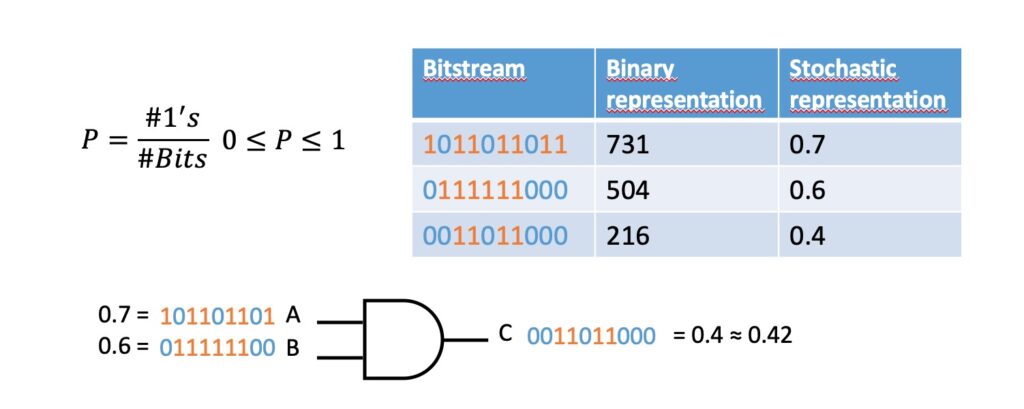Bayesian inference using stochastic computing and spiking neuron circuits

Computing in biological systems is inprecise. We are not particularly good computing machines compared to even a simple calculator. This is fundamentally because our hardware functions in a noisy environment and most events are associated with a probability not with a perfect certainty. This notion inspired von Neumann to develop a computing paradigm based on probabilistic computations, known as stochastic computing. In stochastic computing bitstreams of 0’s and 1’s do not represent a digital number but a probability. For instance a bitstream of 100 would not represent the number 4 but the probability of 1/3 or 0.33. It has been shown that multiplying two probabilities together in such a paradigm can be acheived very simply, with a logical AND gate, if the bitstreams are perfectly decorrelated. A good reference on stochastic computing can be found in [1].
[1] A. Alaghi and J.P. Hayes, ACM Trans Embed Comput Syst 12, 92:1 (2013).


Long before von Neumann proposed stochastic computing, Thomas Bayes. Bayes developed a general law that allows one to determine how much to ‘believe’ that an event will occur given that another event has already occured by describing it as a probability. This type of reason in is widely used in medicine, for instance a child is more likely to have hearing loss due to an ear infection where as in an elderly patient it is more likely due to changes in the inner ear or auditory nerve damage.
It was recently shown that these two ideas, Bayes law and stochastic computing, can be used together in an electronic circuit. [2]
The work at LPICM focuses on numerical modeling. Most notably and in collaboration with our partners, we develop device models (with URV, Spain), circuits and test classification tasks. Our simulations are done in close collaboration with our collaborators working on developing novel thin film devices (University of Surrey), organic electronic technologies. (IMT, Mines-Saint-Etienne, CEA-LITEN, TUD-Dresden). Finally, the development of our classification task is done in collaboration with Bit&Brian in Zarragoza, Spain. This research is funded by an ANR project BAYOEN (link to website) and an EU pathfinder project (BAYFLEX).
[2] J.S. Friedman, L.E. Calvet, P. Bessière, J. Droulez and D. Querlioz, “Bayesian Inference with Muller C-Elements for Error-Prone Nanodevices”, IEEE Trans Circ. Syst. I. 63, 82-85 (June 2016)